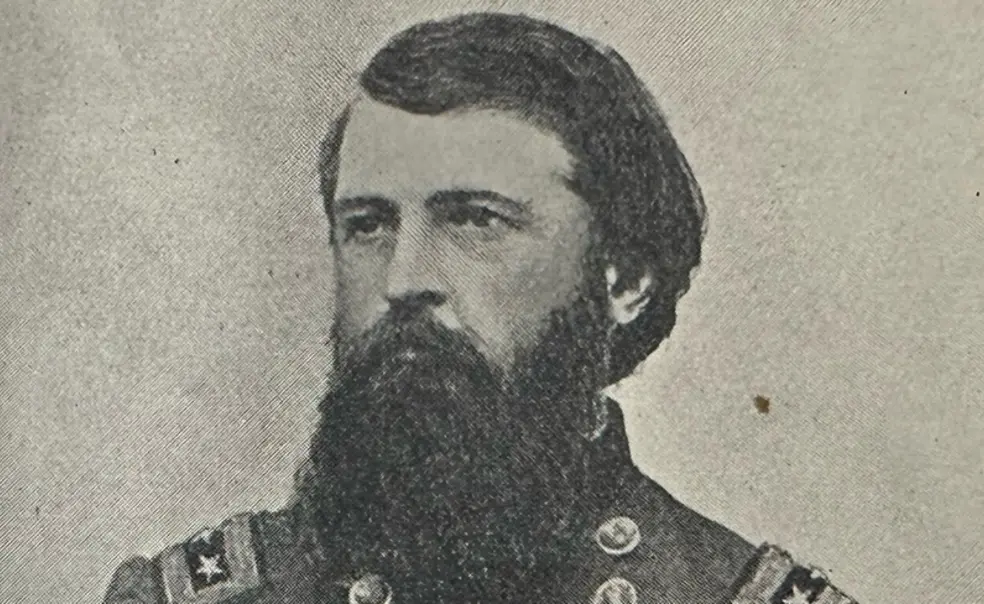A Figure Unique in Annals of United States Army and Navy
Princeton Alumnus Has Distinction of Being Only Officer in American Service History Ever to Hold COmmissions Both as Major-General in Army and Rear-Admiral in Navy
During the course of an examination of some old records of the War Department last summer a unique record in the annals of the military service of the United States came to light. It was that of Samuel Powhatan Carter, a member of the Princeton Class of 1840, and the only American who ever held, in the course of his career, commissions as a major-general in the Army and as a rear admiral in the Navy.
Carter was born in Carter County, Tennessee, on August 6, 1819. He came to Princeotn in the fall of 1838 and entered the Sophomore Class, remaining for only a single year. Instead of returning to complete his last two years and thus receive a Princeton degree, he rounded out his academic career at Washington College in his native state, there being granted his A.B. in 1840. In this latter year he was appointed a midshipman in the United States Navy, and after a course of training he was promoted passed midshipman from the naval school at Philadelphia in 1846. Almost immediately he was called to the colors at the outbreak of the War with Mexico, in the course of which he received his baptism of fire in the taking of Vera Cruz.

In 1847-48 he was attached to the United States Naval Observatory at Washington, and three years later we find him serving as assistant instructor in the United States Naval Academy. He was promoted master there in 1854, and the following year, Lieutenant. That same year he was ordered to the U.S.S. San Jacinto on the Asiatic squadron, and during the course of his two years’ duty at that post he participated in the taking of the Barrier forts in the Canton river.
Returning once more to shore duty, he was again attached to the staff of the Naval Academy, serving there as an assistant instructor in seamanship from 1858 to 1860. Then with the outbreak of the Civil War there came an important turning point in Carter’s career as a warrior under his country’s colors. On July 11, 1861, he was ordered on special service with the army in East Tennessee, and for a number of years which followed he was an army man instead of a member of the naval forces with which he had for so long been identified.
On September 16, 1861, Carter was commissioned Acting Brigadier-General, with the Union Army — a thoroughly military assignment, — and as such he distinguished himself for his gallantry in engagements at Wildcat, Ky., in the latter part of 1861 and at Mill Spring in early 1862, and also in the capture of Cumberland Gap by the Union forces. Carter was promoted to the rank of Brigadier-General on May 1, 1862, was Provost-Marshal of East Tennessee during 1863-64, and was brevetted Major-General of the United States Volunteers on March 13, 1865. He commanded the left wing of the Northern army at Kingston, N.C., in the action on March 10, 1865, and later defeated the Confederates at Goldsboro.
Although he was not mustered out of the army until January 1866, he lost no time after the close of the Civil War in resuming his connection with the Navy, returning to sea duty in 1865 and being promoted to the rank of Commander on June 25 of that year. From 1869 to 1872 he was the Commandant of the United States Naval Academy and was made a Captain early in this period of his service.
Carter was a member of the Lighthouse Board for a thirteen-year period ending in 1880. He was made a Commodore on November 13, 1878, and was retired from active duty in the Navy on August 6, 1881. He was then honored by promotion on May 16, 1882, to the rank of Rear-Admiral on the retired list, this reward coming as a fitting climax to an extraordinary career.
“Admiral-General” Carter died at the nation’s capital on May 26, 1891, his seventy-second birthday being at the time less than three months distant.
This was originally published in the January 18, 1929 issue of PAW.












No responses yet